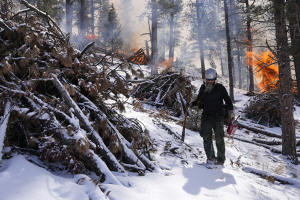Trump wants states to clean up forests to stop wildfires. But his
administration cut off funds
 Send a link to a friend
Send a link to a friend
 [February 14, 2025]
By CLAIRE RUSH, MATTHEW BROWN and CHRIS MEGERIAN [February 14, 2025]
By CLAIRE RUSH, MATTHEW BROWN and CHRIS MEGERIAN
PORTLAND, Ore. (AP) — President Donald Trump's administration is holding
up money for wildfire mitigation projects funded through legislation
championed by his Democratic predecessor, threatening efforts to prevent
catastrophic blazes like the ones that recently ripped through Southern
California.
The decision undermines Trump's repeated insistence that communities
need to clear combustible materials like fallen branches and undergrowth
— “it’s called management of the floor,” he said while visiting Los
Angeles last month — to guard against wildfires.
Elizabeth Peace, a spokesperson for the Interior Department, said via
email that mitigation work is “currently undergoing review to ensure
consistency” with Trump’s executive orders.
The scrutiny is being applied only to projects using money from the
Bipartisan Infrastructure Law and the Inflation Reduction Act, two
centerpieces of former President Joe Biden's administration. They
included roughly $3 billion for wildfire mitigation efforts, often known
as hazardous fuels reduction programs.
Peace said those programs are continuing if funded by other
congressional appropriations.
Lomakatsi Restoration Project, a forest management nonprofit that
develops and implements programs to reduce hazardous fuels and wildfire
threat in Oregon, northern California and Idaho, has stopped work on
projects funded by Biden's legislation, which provides 65% of its $17
million budget.

Executive director Marko Bey said he laid off 15 full-time employees
after being told by federal officials the funding was frozen pending
review, with no information on when it would be released.
“It just doesn’t make good business sense to keep operating, not knowing
if we’re going to get paid or if at some point the administration is
going to rescind some of this,” Bey said. He called it a “really
challenging situation.”
Mitigation work, which includes removing small and dead trees with
logging equipment or through controlled burns, can prevent forests from
becoming tinderboxes. It often takes place in winter and spring in
preparation for warmer months when fires can be more severe. Wildfire
season traditionally starts in May and ends in November, though blazes
can occur year-round because of warmer, drier conditions exacerbated by
climate change.
The latest example came last month in the Los Angeles area, where fires
killed at least 29 people and destroyed nearly 17,000 structures in what
is projected to be among the costliest natural disasters in U.S.
history.
Trump has talked about forest management since his first term, when he
visited California after the Camp Fire killed 85 people in 2018.
“You’ve got to take care of the floors,” he said. “You know, the floors
of the forest, very important.” In Finland, he said, “they spend a lot
of time on raking and cleaning and doing things.”
He issued an executive order intended to improve management of federal
lands, and in 2020 he complained about California officials.
“I said, you gotta clean your floors, you gotta clean your forests,” he
said. “There are many, many years of leaves and broken trees, and
they’re like, like, so flammable, you touch them and it goes up.”
“Maybe we’re just going to have to make them pay for it,” he added,
“because they don’t listen to us.”
Democratic lawmakers have called for federal funding to resume.
“Halting these payments is not only unlawful but also endangers our
rural communities by removing a vital component of their economies and
delaying critical work to mitigate the threat of wildfire,” Sens. Martin
Heinrich New Mexico, Patty Murray of Washington, Jeff Merkley of Oregon
and Amy Klobuchar of Minnesota said Tuesday in a letter to the
administration.
[to top of second column]
|

U.S. Forest Service ranger David Needham walks through a pile of
burning tree debris during a controlled burn in Hatch Gulch, Feb.
23, 2022, near Deckers, Colo. (AP Photo/Brittany Peterson, File)

Harrison Fields, a deputy press secretary at the White House,
defended the administration's approach.
“Just because there’s a review doesn’t mean there’s not a desire for
this work to get done,” he said. “Proper oversight of the dollars is
just as important as ensuring that California gets restored.”
Fields also said that "there has been no bigger advocate for
restoring California to its natural beauty than President Trump,
which is why he made it a point to visit the region in his first
week in office and he’s continuing to put tremendous pressure on
state and local government to reduce the barriers in restoring the
area.”
The review ordered by Trump is also disrupting a $1 billion grant
program that helps local jurisdictions better prepare for fires
through neighborhood risk assessments and community outreach
programs.
Kimiko Barrett of Headwaters Economics in Bozeman, Montana, who
worked with counties in the state to secure Community Wildfire
Defense Grants, said grant recipients were told Monday that payments
had been paused for at least 10 days.
“Coming out of Los Angeles, we have learned that this is a crisis
involving very specific risk reduction efforts,” Barrett said.
“Without this program communities will not have the tools to
continue the very important mitigation work that's needed.”
There are also concerns about how Trump's recent executive order on
downsizing the federal workforce could affect seasonal wildland
firefighters.
McLaurine Pinover, a spokesperson for the Office of Personnel
Management, said firefighters are exempt from the order as public
safety workers.
But confusion has caused delays. Ben McLane, a fire crew captain for
the U.S. Forest Service in Washington state, said uncertainty over
whether firefighters are exempt from the freeze stalled the hiring
process for seasonal wildland firefighter positions.
Applicants whom McLane has selected for his crew have received some
of the information they need to complete — such as medical and drug
tests and fingerprinting — in order to be officially hired. But the
process has not been completed because human resources lacks agency
permission to move forward, he said.
“We’re very confused, and we’re not being told anything,” he said.
“I don’t know whose job it is to say that firefighters are an
essential aspect for public safety and are exempt from the hiring
freeze. But whoever’s job it is, they need to say it, because if
they don’t, then there will be situations where people call 911 and
there aren’t enough firefighters to go around.”

The Bipartisan Infrastructure Law allowed for some small increases
to the 18,700 federal firefighters in 2022, but issues with
workforce understaffing and retention remain. The attrition rate for
firefighters at the U.S. Forest Service has been 45% over the past
four years, a group of Democratic senators said in a second letter
to the administration this week.
“We therefore need to focus on recruitment and retention of this
critically important workforce, rather than place more uncertainty
within it through an arbitrary freeze,” the lawmakers wrote.
___
Brown reported from Billings, Montana, and Megerian from Washington.
Associated Press writer Matthew Daly in Washington contributed.
All contents © copyright 2025 Associated Press. All rights reserved |